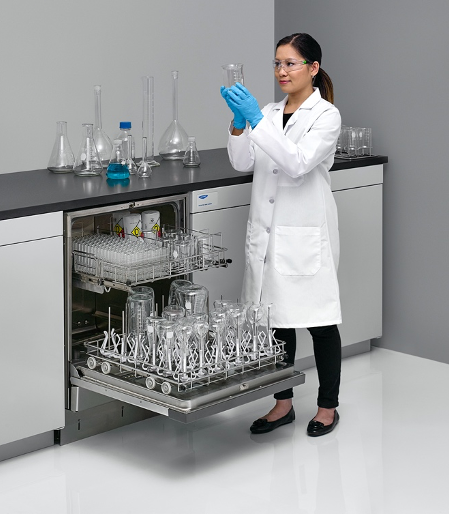Lab Productivity & Optimization
 If you have spent any amount of time in a laboratory, chances are you've hand-washed reusable labware. After all, labware, such as glassware or utensils, is one of the most ubiquitous sets of items in any type of laboratory. Reusable labware touches almost every activity within a lab, including holding samples, preparing reagents and buffers or measuring liquids.
If you have spent any amount of time in a laboratory, chances are you've hand-washed reusable labware. After all, labware, such as glassware or utensils, is one of the most ubiquitous sets of items in any type of laboratory. Reusable labware touches almost every activity within a lab, including holding samples, preparing reagents and buffers or measuring liquids.
For many, washing labware is a mandatory part of lab life, but what may start as a simple task can quickly mount into an extreme burden at the end of a long day – particularly if your space is shared, or your experimentation generates lots of soiled pieces.
Fortunately, incorporating a laboratory glassware washers can provide relief to laboratories who must wash a significant amount of glassware. If you are considering a lab washer, first consider the following challenges faced by your laboratory:
- Is lab washing impeding your ability to carry out important experiments and lab tasks?
- Is excessive water being consumed during washing procedures?
- Are your lab experiments experiencing fluctuation in precision and accuracy?
- Is your lab generating excessive waste of labware that could be reused?
While each and every lab will have different responses to each question, any lab that answers 'yes' to the above questions will benefit from a Labconco glassware washer.
Resource Standardization
Labconco glassware washers, such as the FlaskScrubber and SteamScrubber, utilize CleanWorks® OS, an advanced controls interface that provides full user control over the glassware washing process. A key focus of any lab is to ensure that glassware is readily available for the next experiment, and automating the process of washing reinforces the ability to keep clean glassware ready for use.
Environmental Consciousness
Energy efficiency and water consumption are two key factors that, when lowered, reduce the carbon footprint of a laboratory. Automated, adjustable programming features of Labconco glassware washers allow for precision control of cycles to ensure effectiveness in cleanability while reducing cycle times. Users can select from factory set programs or create their own programs to control the amount of water being used over the entire wash cycle.
Labconco glassware washers reduce the amount of water consumption per each fill – limited to just 12.9L maximum. When compared to hand-washing, Labconco glassware washers can reduce overall consumption of water by as much as 67%. Eliminating hand-washing simultaneously frees up your time in the lab to focus on other key tasks.
Improved Experimental Performance
Experimental performance is directly tied to the materials that are used throughout a protocol. As a result, any reusable labware will have a direct impact on experimental accuracy and precision depending on how it was washed. Lab efficacy is achieved through a number of methods:
- Temperature of water
- Detergent concentration and contact time
- Use of purified water for rinsing
When washing labware by hand, temperature is limited to the maximum temperature of the heating source. These water systems must also adhere to government regulations for safe temperatures of accessible water sources. In most instances, the maximum temperature of water is 120° F (49° C). Viscous and oily materials, or substances that have dried onto labware, can be extremely difficult to remove when hand washing at lower water temperatures. Labconco glassware washers can quickly reach 199° F (93° C) to effectively penetrate stubborn contaminants that would be nearly impossible to remove with 120° F (49° C) water.
Detergent exposure is another key component in the removal of contaminated labware. The application of aggressive detergents through hand washing can be challenging due to skin exposure, and duration of washing required for effective cleaning. Detergent application, and robust washing within Labconco glassware washers ensures substantial contact time at concentrations which ensure the removal of even the most challenging of contaminants. Labconco glassware washers also ensure that detergent residue is eliminated by employing the use of a acid neutralizing rinse to remove basic-natured detergents commonly used with glassware washers.
The rinsing step, which eliminates contaminants from glassware by flushing water throughout labware, should not be overlooked. When performed by hand, it is not uncommon for sections of the labware surface to be missed. Labconco’s glassware washers provide a consistent approach to rinsing, including an available conductivity sensor to validate cleanliness of rinse water for sensitive technique often found in analytical labs. Laboratories who wish to provide purified water for final rinsing can easily plumb a pure source directly to the washer to ensure removal of any residual contaminants that could contribute to carryover. Furthermore, Labconco washers ensure that all drain water passes through a dedicated drain pump further reducing the potential of cross contamination.
Implementing a glassware washer into your laboratory is an important step that can reduce your laboratory’s burden on your staff, the environment and the quality of your results. With a simple evaluation and assessment of your lab’s needs, implementation of a Labconco glassware washer can solve your soiled glassware problem.
Find out how much time, water and energy you could save with with a SteamScrubber or FlaskScrubber Glassware Washer.
| chevron_left | Maintaining laboratory equipment during periods of inactivity: Vacuum Pumps and Cold Traps | Articles | Filtered Fume Hoods: A Simple Solution for Complex Labs | chevron_right |






